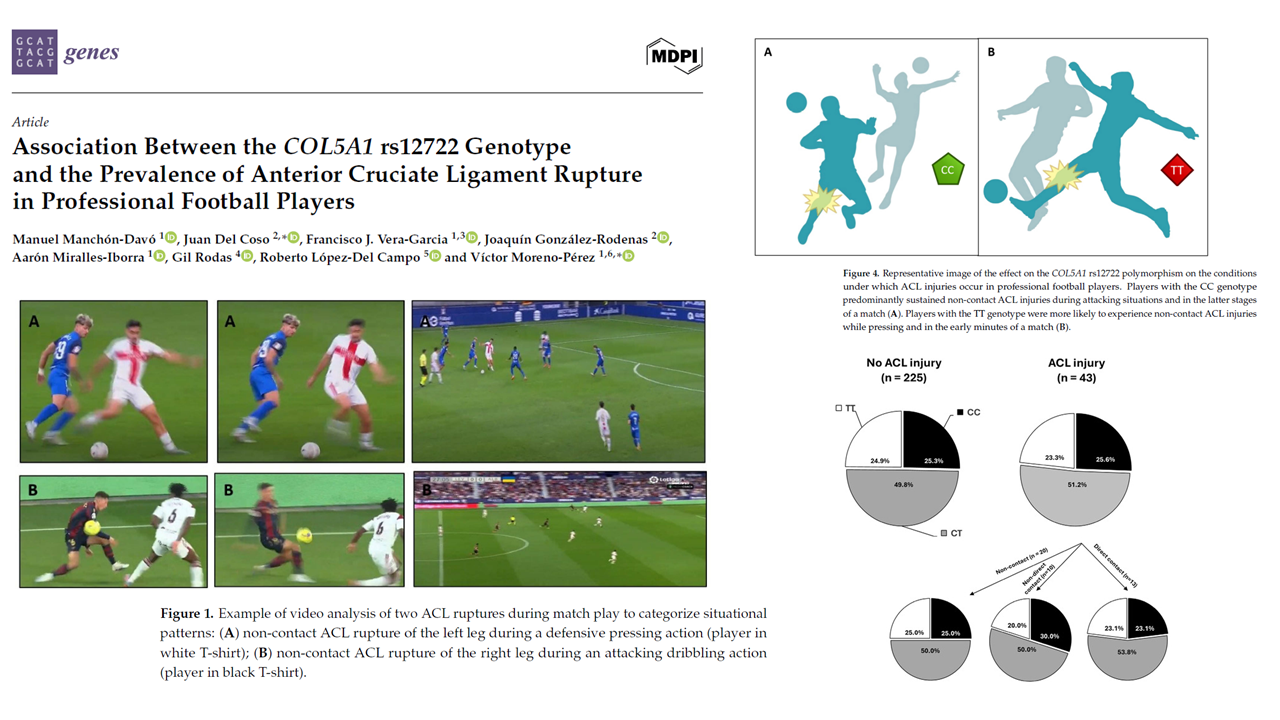
29 May Knowing More to Prevent Better: The Role of DNA in Training Planning
Science reveals genetic patterns that help personalize injury prevention in professional football
Genetics and professional football: how to adapt training based on a player’s biological profile
For decades, injury prevention in professional football has been based on the analysis of physical effort, accumulated load, medical history, and neuromuscular control. Today, thanks to scientific advances, we can add another variable to this equation: the player’s genetic profile.
From the Football Intelligence area of LALIGA, we have developed two recent investigations — published in high-impact scientific journals — that demonstrate how certain genetic variants can influence the types of injuries footballers suffer and how training can be adapted to reduce their risk.
Genetics does not determine who is a better or worse player. It does not dictate talent or limit performance. But it can help technical staff prevent injuries more effectively by providing valuable individual information to design more specific, effective, and safer strategies.
Case 1: COL5A1 and anterior cruciate ligament injury
One of the most feared injuries for any footballer is an ACL tear. In our study with 268 LALIGA players, we analyzed the relationship between this injury and a specific genetic variation of the COL5A1 gene (polymorphism rs12722). Although no direct relationship was found between genotype and overall injury prevalence, very different patterns emerged depending on the genotype when it came to non-contact injuries.
Full study: https://doi.org/10.3390/genes16060649
What did we find?
Players with CC genotype:
- More frequently injured their dominant leg
- Injuries occurred during offensive actions (sprints, finishes, landings)
- Often happened in the last 15 minutes of the match
Practical application: Design preventive strategies focused on managing fatigue, motor control, and strength in offensive actions under high load.
Players with TT genotype:
- Greater tendency to injure the non-dominant leg
- Injuries associated with defensive actions (pressing, changes of direction)
- More frequent in the first 15 minutes of the match
Practical application: Prioritize specific warm-ups and intermuscular symmetry work, especially in high-demand defensive tasks.
CT genotype players displayed a mixed profile.
These findings underscore that non-contact injury risk is not random: it may be influenced by the genetic structure of connective tissue and manifests in recurrent patterns that are useful for individual planning.
To complement this genetic information, LALIGA provides its 42 clubs with Mediacoach Live, a tool that enables real-time monitoring of all players’ physical effort and triggers alerts when a player nears a risk threshold. The tool informs, the coach decides.
Case 2: ACTN3 and muscle injury risk
The second study focused on the ACTN3 gene, known as the «speed gene» due to its role in the presence of fast-twitch muscle fibers. Specifically, we analyzed the XX variant, which prevents the production of the α-actinin-3 protein.
Among the 305 professional footballers analyzed, 18% presented this genotype, and the results were clear:
Full study: https://doi.org/10.3390/genes15030386
Players with XX genotype:
- Showed lower performance in explosive efforts (accelerations and sprints)
- Recorded a higher incidence of muscle injuries, especially in the hamstrings
How do we apply this?
- Implement individualized load control strategies
- Prioritize eccentric strength work, especially for the hamstrings
- Schedule preventive rest and active recovery during high-intensity competitive weeks
- Adjust speed training to avoid excessive exposure without adaptation
The presence of this genotype is not a limitation. It’s a call to intelligently manage load.
In this context, tools like Mediacoach Live allow for daily monitoring of a player’s physical performance, comparing data against expected profiles, and taking action in advance. Technology and science in service of personalized prevention.
Conclusion: train with more knowledge, not more judgment
Genetics applied to professional football is not a filter, nor should it be used for scouting decisions. There is no such thing as the “DNA of the perfect footballer.” But we now know that, all else being equal, there are profiles that may benefit from a more specific preventive approach.
Having this information is not exclusive — it is inclusive. It helps us better care for our players, adapt their preparation, and optimize their availability. Knowledge is prevention.
At LALIGA, we will continue to investigate and translate scientific knowledge into a useful, practical language for coaches. Because planning with science is caring with intelligence.
And for this science to be truly useful in daily routines, all LALIGA clubs have access to Mediacoach Live, a pioneering solution that translates physical data into actionable alerts during the match. When genetic analysis is combined with real-time monitoring, prevention becomes an informed decision.


